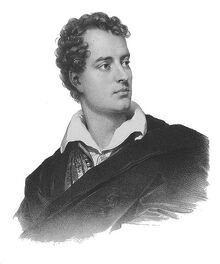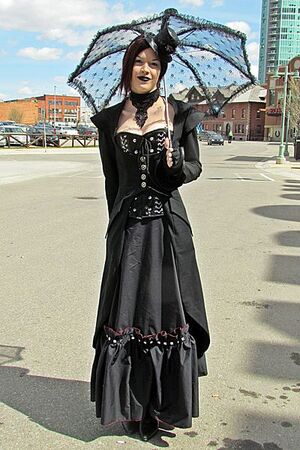
George Gordon Byron (1788-1824).
"She Walks in Beauty" is a poem written in 1814 by George Gordon, Lord Byron. One of Byron's most famous, it is a narrative poem that describes a woman of beauty and elegance. The poem appears to be told from the view point of a third person. There are no hints as to the identity of the narrator; it is believed that the narrator may be Byron himself.
She Walks in Beauty[]

"Steampunk Goth". Photo by Sergei ~5of7, 2012. Licensed under Creative Commons, courtesy Wikimedia Commons.
She walks in beauty – like the night
Of cloudless climes and starry skies;
And all that's best of dark and bright
Meet in her aspect and her eyes:
Thus mellow'd to that tender light
Which heaven to gaudy day denies.
One shade the more, one ray the less,
Had half impair'd the nameless grace
Which waves in every raven tress,
Or softly lightens o'er her face;
Where thoughts serenely sweet express
How pure, how dear their dwelling-place.
And on that cheek, and o'er that brow,
So soft, so calm, yet eloquent,
The smiles that win, the tints that glow,
But tell of days in goodness spent,
A mind at peace with all below,
A heart whose love is innocent!
Audio[]

Byron ~ She Walks In Beauty ~ poem with text
Author[]
"She Walks in Beauty" was written by George Gordon Noel Byron, also known as Lord Byron, one of the most influential writers of his time. Byron was born on January 22, 1788, to Captain 'Mad Jack' Byron and Catherine Gordon.[1] After losing his father at a young age and inheriting the family title and estate, he went on to Harrow school, followed by an attendance to Cambridge.[1] After leaving Cambridge, Byron went on to have many travels and to develop a career that was very successful.[1] Byron died of malaria in April 1824.[1]
History[]
The poem is said to have been inspired by the vision of Byron's cousin by marriage in a mourning gown. Once, while at a ball, Byron happened upon a beautiful woman as she walked by. That woman was Byron's cousin by marriage, Mrs. John Wilmot, and the next morning the poem was written.[2] She was in mourning, wearing a black dress set with spangles, which would explain the opening lines;
| “ | She walks in beauty, like the night Of cloudless climes and starry skies |
” |
However, Nathan, in his reminiscences of Byron, indicates that the subject of the poem may have been Byron's half-sister, Augusta.[3]
"She Walks in Beauty" was the first of several poems to be set to Jewish tunes from the synagogue by Isaac Nathan, which were published as Hebrew Melodies in 1815.[4]
Form[]
The poem consists of 3 6-line stanzas which are Sicilian sestets, written in Iambic tetrameter with a rhyme scheme of A-B-A-B-A-B.
Analysis[]
"She Walks in Beauty" is considered to have been Byron's tribute to the beauty of art.[5]
The poem begins with the image of a woman who 'walks in beauty like the night', which would lead the reader to ask how she could be found.[6] That question is answered in the next line when the speaker says that the night is cloudless and that the stars illuminate the sky, bringing into focus the imagery of light and darkness.[6] When the first line of a poem is presented with no punctuation, but is followed by a line that will clarify the previous statement, it is referred to as enjambment, and this technique is used in the first four lines of the poem.[6]
In the next few lines Byron draws attention to the word meet; it emphasizes the contrasts in the woman being described; the imagery presented in the first two lines reappears in these lines, and the contrast of light and dark makes another appearance.[6] The light and dark appear in her face and in her eyes. Her face contains light alabaster skin, yet has dark hair, and her eyes are dark in the iris in contrast with the white of her eye. This repeat of the contrast between light and dark reinforces the imagery introduced in the beginning of the poem.[6]
The poem goes on to say that if she were to have even one bit more light or less dark she would not be ruined but she would be only half impaired.[6] As the poem begins to end Byron speaks of the woman's inner thoughts and how they are all good, which serves to convey the woman as pure , making her all the more beautiful.[6] The reference to her angelic looks gives a window into her morality as a person, and enhances her beauty all the more.
According to Uma Kukathas there is a contrast of light and dark in the poem can easily be a representation of what art is in its entirety; there are so many varying, contrasting parts of art and yet it all comes together to create something that is beautiful.[5] The contrast of light and dark is used to convey the soft beauty of the woman; the beauty is soft and pronounced but not overdone.[5] The woman's beauty is soft like candlelight, it is not too over-powering and yet her beauty is still obvious to all who look at her.[5] The dark part of the contrast serves as a reality check to make the woman seem more worldly and real, it creates flaws and yet if she were to have even one bit more light or darkness she would only be 'half-impaired'.[5] Byron speaks of her 'nameless grace', in which one would think he were speaking of her grace as she walks but, he is really speaking of the grace she possesses from the darker features of her face, which serve to enhance her beauty in the speakers eyes.[7]
See also[]
References[]
- ↑ 1.0 1.1 1.2 1.3 "George Gordon Noel Byron." Encyclopedia of World Biography. 2nd ed. Vol. 17. 1998. Gale Virtual Reference Library. Web. Aug.-Sept. 2010
- ↑ Cummings, Micheal J. "Byron's She Walks in Beauty: a Study Guide." Free Study Guides for Shakespeare and Other Authors. 2008. Web. 27 Sept. 2010. <http://www.cummingsstudyguides.net/Guides5/SheWalks.html>.
- ↑ The complete works of Lord Byron, A. and W. Galignani, 1841, p. 254, http://books.google.com/books?id=nEoJAAAAQAAJ&pg=254
- ↑ . Kelly, David. 'Critical Essay on 'She Walks in Beauty'. Poetry for Students. Ed. Anne Marie Hacht.Vol.14.Detroit:Gale Group,2002.Literrary Resource Center.Web.24 Sept. 2010.
- ↑ 5.0 5.1 5.2 5.3 5.4 Kukathas, Uma. "Critical Essay on 'She Walks in Beauty'" Poetry for Students. Ed. Anne M. Hacht. Vol. 14. Detroit: Gale Group, 2002. Gale Virtual Reference Library. Web. Aug.-Sept. 2010.
- ↑ 6.0 6.1 6.2 6.3 6.4 6.5 6.6 . Hacht, Anne M., ed. "Overview: 'She Walks in Beauty'" Poetry for Students. Vol. 14. Detroit: Gale Group, 2002. Gale Virtual Reference Library. Web. Aug.-Sept. 2010.
- ↑ Hacht, Anne M., ed. "Overview: 'She Walks in Beauty'" Poetry for Students. Vol. 14. Detroit: Gale Group, 2002. Gale Virtual Reference Library. Web. Aug.-Sept. 2010.
External links[]
- Text
- She Walks in Beauty" in the Oxford Book of English Verse 1250-1900
- Audio / video
- About
- "She Walks in Beauty, Like the Night" in Lord Byron's Poems Study Guide
- She Walks in Beauty: A study guide
| This page uses Creative Commons Licensed content from Wikipedia. (view article). (view authors). |
| This page uses content from Wikinfo . The original article was at Wikinfo:She Walks in Beauty / Byron. The list of authors can be seen in the (view authors). page history. The text of this Wikinfo article is available under the GNU Free Documentation License and the Creative Commons Attribution-Share Alike 3.0 license. |